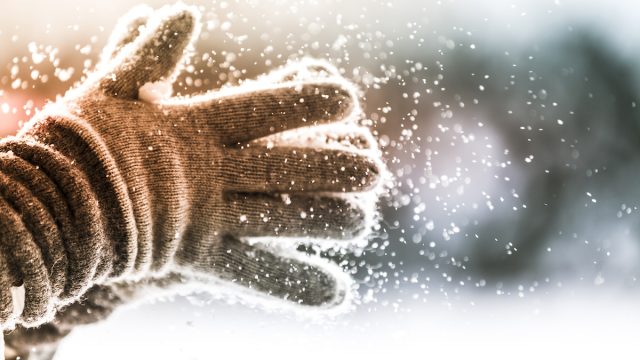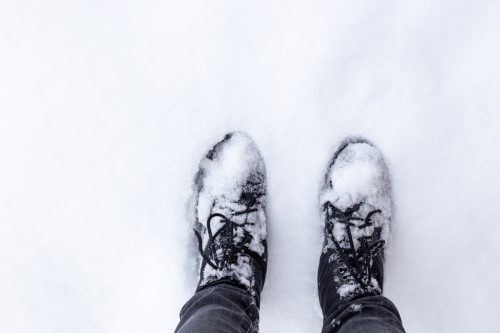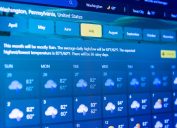"False Spring" Is Heating Up the U.S., But Get Ready for Winter's Brutal Comeback
Above-average temperatures have been reported across the U.S., but they're not here for long.

We've been hit with several storms and arctic blasts this winter, but we've also experienced some intermittent relief and above-average temperatures. Right now, those climbing temps have many Americans feeling like it's already well past February. But while you might be spending more time outside and enjoying the "false spring," be prepared to bundle up again, because winter will be returning with a vengeance. Read on to find out when you'll need to crank the heat again.
RELATED: Winter Storm Could Bring More Than 10 Inches of Snow to These Regions.
Parts of the U.S. are having borderline balmy weather.

While "the calendar says February," it has felt "more like April" across Central and Eastern U.S. this week, AccuWeather meteorologist Alyssa Glenny wrote on Feb. 5.
On Tuesday, Feb. 6, temperatures in some areas were almost double the historical average—in Minneapolis, it reached a shocking 57 degrees. The surprising high beat the previous record of 51 degrees, which hasn't been topped in 99 years, WCCO News reported. In early February, the average high in the Twin Cities is only 25 degrees, USA Today reported.
Additionally, those in the Northeast and the Great Lakes were "basking in the sunshine" over the weekend through Monday and Tuesday, according to Accuweather meteorologist Dean DeVore. But for the remainder of this week, warmer temperatures are likely to shift north and east.
Those in the Plains and the Northeast should notice somewhere between a 5- to 15-degree shift today and then again from Sunday to Monday, per AccuWeather. Today or tomorrow, temperatures in the Central and Southern Plains—like Little Rock Arkansas; Shreveport, Louisiana; and Dallas—may even see the high 70s.
RELATED: "Polar Vortex Disruption" Will Send U.S. Temps Plummeting—Here's When.
Warmth will stick around for a bit longer.

The National Weather Service (NWS) Prediction Center notes that "much above average temperatures" will continue through the end of the work week for the Central and Eastern U.S., with record warmth slated for locations in the Great Lakes and the Mid-Atlantic.
Through Saturday, highs in the 40s and 50s are predicted for the Upper Midwest and the Great Lakes, while the Middle Mississippi Valley may see temps in the 50s, which is upwards of 25 to 35 degrees above average, the NWS notes. In the South, from the Southern Plains into the Southeast, highs will be somewhere in the 60s and 70s.
As AccuWeather senior meteorologist Bob Larson told USA Today, we have the jet stream to thank for these spring-like temperatures. Because of where it's positioned right now, it's moving mild air to the Central and Eastern U.S., he said. The jet stream's strength is also keeping colder air in Canada as opposed to moving it south to the U.S.
RELATED: "Extended Winter" May Keep Things Cold in These Regions, Meteorologists Predict.
The jet stream is on the move, meaning temperatures will drop.

While warmer temperatures are a nice reprieve from cold and snow, it's not going to last forever: Wintry weather will soon be returning to certain regions.
The jet stream is set to reposition, Larson told USA Today, and temperatures will drop as a result. The Central and Eastern U.S. will feel colder air from Canada, and snow is also a possibility in the Northeast, he said. Extreme cold and storms are also likely by the end of next week.
"A 'word to the wise,' enjoy the next 10 days or so, because some winter cold and winter-type weather will likely come back into play for the eastern U.S. prior to and even beyond Valentine's Day for the second half of February," DeVore said, per USA Today.
We also have to contend with the polar vortex.

Making things a bit more complicated, a "polar vortex disruption" could also affect weather across the U.S. Judah Cohen, director of seasonal forecasting for Verisk Atmospheric and Environmental Research, says that changes with the vortex are slated for mid-February.
As of Feb. 5, the latest near-term outlook showed an elongation of the vortex around Feb. 15. Just a few days later, it could split, change its trajectory, and send colder air down to the northern U.S. A temperature forecast map suggests people in the Midwest, Northeast, and northern areas of the Southeast could see temperatures around 5 degrees colder than usual between Feb. 16 and 20, meaning many areas may be well below freezing.
Echoing Cohen's predictions, Fox Weather meteorologist Britta Merwin reiterated in a Feb. 2 segment that "we have a little more winter weather to get through."
She, too, pointed to a computer model that anticipates a mid-month temperature drop due to the polar vortex disruption.
"It means that arctic air is going to break away from the poles and move into the northern part of the U.S.," Merwin said. "This is what's key for winter weather across areas like the Great Lakes in the Northeast. We have to have that arctic air move into the country for us to get big snowstorms."
RELATED: For more up-to-date information, sign up for our daily newsletter.
- Source: NWS: Weather Prediction Center





















